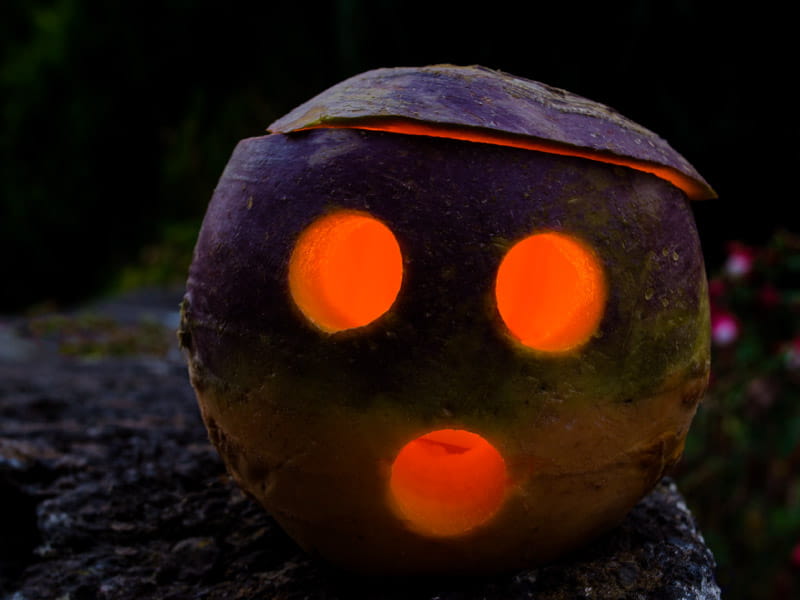Does the turnip's spooky tale make the veggie a nutritional trick – or a treat?
By Michael Merschel, American Heart Association News

This time of year, pumpkins tend to hog the spotlight – at least in publications that cover potentially frightening produce. But for people interested in vegetables with a truly haunting past, allow us to turn to … turnips. (Cue the evil laughter and scary music.)
No, seriously. Before pumpkins were carved into jack-o'-lanterns at Halloween, people in Ireland were carving scary faces into turnips to frighten away evil spirits as part of the Celtic festival of Samhain.
That's not the only example of bad vibes being tied to turnips. Ancient Romans threw them at unpopular leaders. For hundreds of years, "turnip" has been associated with being a rube; Mark Twain and Shakespeare were among those who used it as an insult, or at least to score a laugh. Its hardiness means it has helped nations stave off starvation but also left it associated with poverty – or something more fit for livestock than lunch.
Turnips still inspire shudders in some quarters. Look for recipes, and you might come across terms such as "oddball," "ugly duckling" or even "hated."
So, are turnips a terrible trick or a healthy treat? Let's root around in the facts and find out.
"In most parts of the U.S., turnips aren't a very popular vegetable," concedes Jillian Kubala, a registered dietitian based in Westhampton, New York. "They're more common in Southern cuisine, and they're a staple vegetable in many other parts of the world, including Northern Europe."
Turnips seem to have been first domesticated in Central Asia around 3,400 to 5,900 years ago. Bok choy is a direct descendant, as is the rutabaga, which is actually the hybrid of cabbage and turnips.
The turnip is a cruciferous vegetable, a close cousin to broccoli, Brussels sprouts and kale. Federal dietary guidelines recommend adults eat 1.5 to 2 cups of fruit each day and 3 to 4 cups of vegetables. Cruciferous vegetables are among the foods that a 2020 study in the Journal of the American Heart Association linked to better heart health.
Like Dr. Jekyll and Mr. Hyde, a turnip is really two things in one. Unlike that classic monster, both halves of the turnip end up being rather nice to have around.
When eaten raw, the bulbous white roots have what Kubala calls "a slightly spicy flavor, but they become milder and sweeter when cooked." They're also "packed with nutrients, such as fiber and vitamin C."
One cup of cooked, mashed turnips has only 51 calories but provides 27 milligrams of vitamin C, roughly a third of what an adult needs daily. The same serving contains about 5 grams of fiber. "Fiber is essential for gut health, as it fuels the growth of beneficial bacteria in the digestive tract and keeps bowel movements regular and easy to pass," Kubala said.
The turnip root is rich in plant compounds, such as glucosinolates and flavonoids, that have antioxidant and anti-inflammatory properties, she said.
Leafy turnip greens, meanwhile, can be enjoyed on their own. "The greens have an earthy, slightly peppery flavor," Kubala said, and are an excellent source of vitamins and minerals, including vitamin A, vitamin K and folate. One cup of boiled, drained turnip greens has 29 calories and 5 grams of fiber.
Both the root and the greens are low in carbohydrates. "Because turnips are low in carbs and high in fiber and other important nutrients, they can be used as a healthy, low-carb alternative for higher-carb dishes," Kubala said. A cup of mashed turnips has less than 12 grams of carbohydrates, compared with 44 grams in the equivalent serving of mashed potatoes.
Turnips do come with a couple of cautionary notes, however. Fittingly for the season, those warnings involve both blood and guts.
Vitamin K, which plays an important role in blood clotting, can interfere with the blood thinner warfarin. So, people who use that medication are advised to check in with a health care professional regularly and be consistent in how much vitamin K they consume. People eating turnips "in normal amounts" shouldn't have problems, Kubala said.
Turnips also contain a type of sugar called raffinose. "Raffinose resists digestion and is instead broken down or fermented by bacteria in the large intestine," Kubala said. "This process can cause gas, bloating and stomach discomfort in some people." Cooking turnips reduces raffinose levels, making them easier on the digestive system.
Turnips once were seen as a food fit for an emperor. Today, there are those who still celebrate them. Vermont named the Gilfeather turnip – a cross between a turnip and a rutabaga – its state vegetable in 2016, and an annual festival is held each October in its honor.
That's perhaps small potatoes compared with the annual Räbechilbi festival in the Swiss town of Richterswil. There, each November, turnips are carved into lanterns and displayed on elaborate floats, sort of like the Tournament of Roses parade in Pasadena, California, but without the thorns and, presumably, a different aroma.

There are many simpler ways to jump on the turnip bandwagon. The greens can be eaten raw in salads, tossed into soups or used in recipes that call for collard greens. Raw, the root can be sliced and used in a salad.
The greens are delightful when sauteed with olive oil and garlic, Kubala said. Mashed turnips, meanwhile, are "delicious and have a creamy texture. I suggest trying mashed turnips in place of mashed potatoes if you're looking for an easy way to incorporate new vegetables into your diet."
And while nobody is suggesting handing turnips out on Halloween, when it comes to determining whether they're a trick or a treat, Kubala isn't afraid to declare them "definitely a healthy treat."
Eat It or Leave It? is an American Heart Association News series that takes a closer look at the health benefits and drawbacks of specific foods and drinks.





